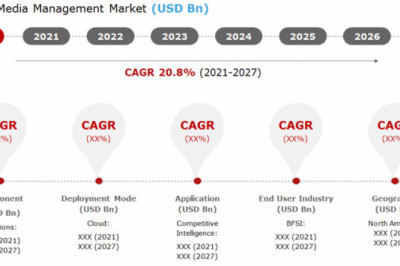views

TheLDAR market was valued at USD 18.9 billion in 2020 and is predicted to reach USD 25.9 billion by 2027, growing at a CAGR of 5.4% from 2021 to 2027. The gas leak detection systems are majorly used in the oil and gas industry to detect leaks on drilling platforms (upstream), pipelines, trailers, and tanker vessels (midstream), and refining & storage facilities (downstream). It is necessary to detect, monitor, and repair leakage immediately due to the highly combustible nature of oil and gas products.
Many countries are focusing on expanding the oil and gas pipeline networks as it is considered the safest and most cost-effective mode of transportation. Pipelines enable the safe transportation of oil and gas through urban areas with minimal obstructions. Multiple cross-country oil and gas pipelines are being planned for the faster transport of hydrocarbons. They are expected to propel the growth of the lead detection and repair systems market. Leaks can occur due to high temperature and pressure, and corrosion conditions. The presence of oxygen, water, carbon dioxide, and hydrogen sulfide in crude oil and natural gas is the primary cause of pipeline/tanker vessel corrosion. Corrosion can be internal as well as external. Internal corrosion is caused due to constituents in natural gas and crude oil, whereas external breakdown mainly occurs due to temperature change and rainfall, among other natural factors. Hence, companies focus on improving their maintenance and safety processes to reduce and eliminate the emission risk.
Get Full PDF Sample Copy of Report: https://www.marketstatsville.com/request-sample/leak-detection-and-repair-market
Increased concerns regarding the emission of harmful greenhouse gases, expansion of oil & gas pipeline infrastructure, and stringent government rules & regulations, and policies are expected to be the major drivers for the growth of the leak detection and repair market over the forecast period.
Global Leak Detection and Repair Market Dynamics
Drivers: Stringent government regulations to curb methane emissions
Methane is a dominant greenhouse pollutant and is considered 80 times more powerful and harmful than carbon dioxide, a major greenhouse gas. According to scientists, methane contributes approximately 25% to global warming. Hence, various governments are introducing regulations and initiatives to reduce methane emissions.
In 2016, the U.S. Environmental Protection Agency (EPA) proposed regulations that required the use of Optical Gas Imaging (OGI) technology to identify and repair gas leaks. The Quad Oa regulation, as part of the EPA Oil & Gas Sector New Source Performance Standards, recommends the use of LDAR for oil and gas operation sites (compressor stations, wellheads, gas plants, transmission, and underground gas storage, among others) constructed after September 18, 2015. It also specifies the bi-annual or quarterly surveys to be performed using OGI cameras or a Method 21 device to detect methane and VOC leaks that may occur at any facility.
Restraints: Challenges involved in leak detection in harsh environmental conditions
The oil and gas extraction platforms are established across remote geographical regions such as the Gulf of Mexico, North Sea, Persian Gulf, Alaska, and The Western Siberia Basin. Some are also located off-shore. These regions have different topography and climatic conditions, due to which deploying gas leak detection and monitoring systems prove to be a major challenge. This further leads to an increased need for leak detection and monitoring systems.
Moreover, harsh and unpredictable climatic conditions also add to the complexity. High system costs and technological limitations have hampered the methane leak detection process from oil and gas extraction platforms and refining plants. These factors have also limited the efforts to deploy a continuous monitoring system.
Challenges: Multiple components leaks add to increased complexity in the detection
Methane is the primary natural gas and is also a potent greenhouse gas. Methane leaks can occur in valves, seals, connectors, meters, pipelines, and storage tanks. Hence, the on-time leak detection of methane is a growing need across the oil and gas industry. Both fixed and portable gas leak detection systems detect leaks in the oil and gas industry. Currently, most of the oil and gas pipelines are equipped with flow rate measurement sensors. In case of a leak, these sensors detect pressure drops. However, according to a U.S. Department of Transportation report, these sensors successfully detect leaks only around 40% of the time.
The Association of Oil Pipelines (AOPL) has launched a Leak Detection Rupture Monitoring project under the Pipeline Leadership Initiative to formulate additional strategies for continuous improvements in leak detection. AOPL has also developed performance standards for the industry. However, effective detection and monitoring of methane leakage in multiple components provide a major challenge for companies.
Make an Enquire before Purchase @: https://www.marketstatsville.com/buy-now/leak-detection-and-repair-market?opt=2950
Scope of the Report
The study categorizes the leak detection and repair market based on product, component, technology, and region.
By Product Outlook (Sales/Revenue, USD Million, 2017-2027)
- Handheld Gas Detectors
- UAV-based Detectors
- Vehicle-based Detectors
- Manned Aircraft Detectors
By Component Outlook (Sales/Revenue, USD Million, 2017-2027)
- Equipment
- Service
By Technology Outlook (Sales/Revenue, USD Million, 2017-2027)
- Volatile Organic Compounds (VOC) Analyzer
- Optical Gas Imaging
- Laser Absorption Spectroscopy
- Ambient/Mobile Leak Monitoring
- Acoustic Leak Detection
- Audio-Visual-Olfactory Inspection
By Region Outlook (Sales/Revenue, USD Million, 2017-2027)
- North America (US, Canada, Mexico)
- South America (Brazil, Argentina, Colombia, Peru, Rest of Latin America)
- Europe (Germany, Italy, France, UK, Spain, Poland, Russia, Slovenia, Slovakia, Hungary, Czech Republic, Belgium, the Netherlands, Norway, Sweden, Denmark, Rest of Europe)
- Asia Pacific (China, Japan, India, South Korea, Indonesia, Malaysia, Thailand, Vietnam, Myanmar, Cambodia, the Philippines, Singapore, Australia & New Zealand, Rest of Asia Pacific)
- The Middle East & Africa (Saudi Arabia, UAE, South Africa, Northern Africa, Rest of MEA)
Request for Complete TOC and Figures & Graphs @ https://www.marketstatsville.com/table-of-content/leak-detection-and-repair-market
The handheld gas detectors segment is projected to account for the largest market share by product
Based on product, the LDAR market has been segmented into handheld gas detectors, UAV-based detectors, vehicle-based detectors, and manned aircraft detectors. Handheld Gas Detectors is accounted for the largest market share in 2020 and have a market share of 37.3%. Handheld gas detectors are widely used in the oil & gas sector owing to their cost-effectiveness and portability. These detectors are commonly used for monitoring pipeline operations and for detecting different gases, such as Methane (CH4), Carbon Dioxide (Co2), Methanal (H2CO), Carbon Monoxide (CO), and Ammonia (NH3), among others. In addition, these detectors are used for VOC analyzers to detect leakage in components such as valves, pumps, connectors, compressors, and open-ended lines, among others. Moreover, handheld gas detectors are also used in Method 21 for monitoring fugitive emissions. Thus, the demand for handheld gas detectors in the oil & gas sector is expected to grow owing to rising natural gas production, increasing trade of oil and gas products, the growing pipeline infrastructure, and the implementation of associated regulatory policies.
Middle East & Africa accounts for the highest CAGR during the forecast period
Based on the regions, the global leak detection and repair market has been segmented across North America, Asia-Pacific, Europe, South America, and the Middle East & Africa. During the forecast period, the Middle East & Africa is projected as the fastest-growing region market with a CAGR of 7.6%. Countries in the Middle Eastern region have a high economic dependence on the oil and gas sector. Oil & gas companies have witnessed significant growth over the last decade and are now undertaking measures to stay competitive in the rapidly evolving global oil & gas industry. These companies have the financial resources to deploy leak detection and repair systems to reduce methane emissions and maintain industry competitiveness.
Africa provides a huge opportunity for growth and expansion in the oil & gas industry. However, some of the major issues hampering the development of the industry in Africa include lack of strong transportation and logistics infrastructure network, unstable political and economic environment, and lack of finance for the development of new exploration and production projects. Saudi Arabia has initiated projects to collect and reuse methane gas through Vapor Recovery Technologies. The country has also recommended oil and gas companies to deploy the Solar Occultation Flux technique for reducing methane emissions. This initiative intends to measure the actual VOC emissions of various oil and gas production and refining facilities. It is also focusing on increased adoption and implementation of LDAR systems in oil and gas facilities.
Request For Report Description @ https://www.marketstatsville.com/leak-detection-and-repair-market
Key Market Players
The leak detection and repair market is mildly concentrated in nature with few numbers global players operating in the market such as Aeris Technologies, Inc., IBM Thomas J. Watson Research Center, Bridger Photonics, Inc., LI-COR, Inc., Duke University, Summit Inspections Services, Inc., GHD, Inc., ERM Group, Inc., AECOM, Guardian Compliance, ABB Ltd., Chicago Bridge & Iron Company N.V., Heath Consultants, ENCOS, Inc., Team Inc., VelocityEHS, Picarro Inc., Microdrones GmbH, Boreal Laser Inc., and Kairos Aerospace.












